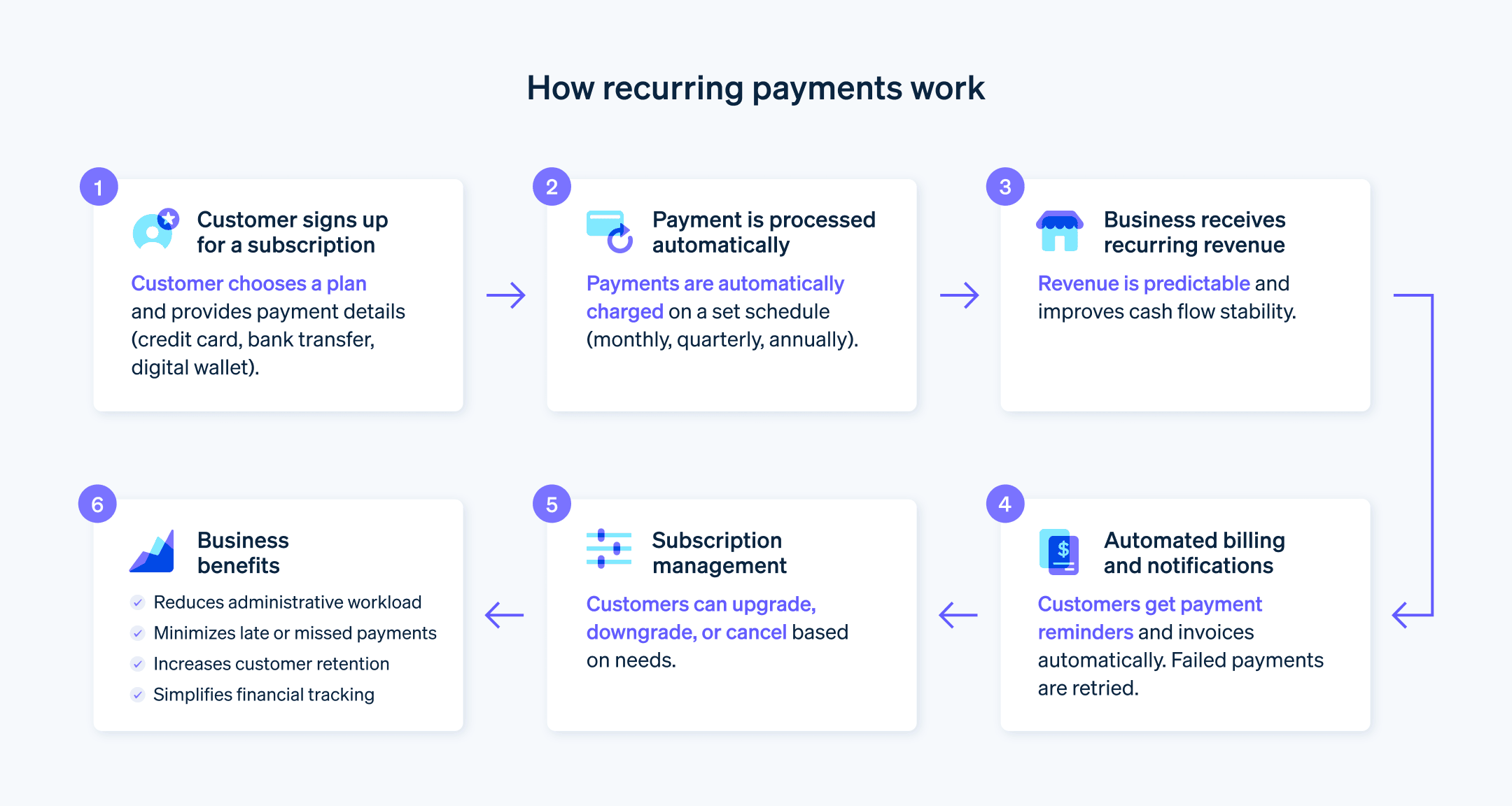经常性付款有可能改变企业。它们产生可预测的收入,显著减少管理任务,并促进与客户建立牢固、持久的关系。2022 年全球经常性付款的市场价值为 1300 亿美元,预计到 2033 年将增长至 2680 亿美元。
经常性付款可以改善客户的支付体验,使用经常性付款模式的企业可以降低客户流失率。对于企业来说,经常性付款可以提供可靠的收入,并能够更准确地预测未来收入。
下面,我们将介绍如何设置经常性付款模式,帮助您为您的企业获得这些实质性的好处。
本文内容
- 如何设置经常性付款
- 经常性付款对企业的优势
- 哪些类型的企业提供经常性付款?
- 实施经常性付款模式时要考虑的事项
- Stripe Billing 如何提供帮助
- 了解 Stripe Billing 的行业地位
如何设置经常性付款
经常性付款,也称为订阅付款或自动付款,是指按照预先安排的计划自动从客户的信用卡或银行账户中扣除的款项。它们通常用于支付水电费、健身房会员费、订阅服务和软件许可证费用。
经常性付款通常按月进行,但也可以按周、按季度或按年进行。经常性付款为客户带来了便利,因为他们不再需要记住每笔付款。此外,因错过付款而导致服务中断的可能性也更小。对于企业而言,经常性付款可以提供可预测的收入并降低管理成本。
以下是设置经常性付款的分步指南:
1.了解您的业务需求: 确保您清楚了解您的业务模式和需求。您的产品或服务是否适合经常性付款结构?此模式对提供基于订阅的服务、会员制或长期合同的企业最有利。
2.选择合适的定价模式: 经常性付款需要考虑不同的定价模式:包括固定费率、分层、每用户、基于用量和免费增值等。最佳模式将取决于您的特定产品或服务、客户群和整体业务战略。
3.选择可靠的支付网关: 选择安全、可靠的支付网关,该网关符合 PCI DSS 标准,并提供自动付款重试、催款管理以及与现有业务系统的简单集成等功能。
4.合规检查: 确保您的经常性付款模式符合所有适用的法律和法规要求。这可能包括您运营所在国家/地区的当地法律、国际法规(如果您在全球范围内运营)以及与安全支付处理相关的财务法规。
5.设置经常性付款系统: 使用所选的支付网关,设置您的经常性付款系统。这将涉及设置付款频率(例如,每周、每月、每年)、根据您选择的定价模式设置价格,并可能根据客户的订阅层级或用量对客户进行细分。
6.提供多种付款选项: 为了提供更顺畅的客户体验,请提供多种付款选项,包括信用卡和借记卡、银行转账和数字钱包。这种灵活性可以增加客户选择您的服务并坚持使用的机会。
7.处理客户授权: 在开始经常性向客户收费之前,您需要获得他们的明确同意。建立一个系统来安全地捕获和存储此授权。
8.清晰地沟通: 清晰的沟通有助于建立信任并减少客户投诉和争议。确保您的客户了解经常性付款的条款和条件,包括金额、计费周期以及他们如何取消或修改订阅。
9.针对失败的付款的计划: 即使有可靠的支付网关,您也需要一个策略来处理失败的付款。考虑设置自动重试,向客户发送电子邮件通知,并在付款成功前暂停服务。
10.提供客户支持: 卓越的客户支持可以显着增强客户体验。您的支持团队应接受过培训,能够处理与经常性付款有关的所有咨询,确保快速有效地解决任何问题。
设置经常性付款需要精心策划和实施,但付出的努力可以换来更可预测的收入、更好的现金流和更高的客户保留率。

经常性付款对企业的好处
经常性付款可为企业提供许多好处。以下是一些主要优势:
收入的可预测性
企业不必担心客户何时以及是否会一次性付款,而是可以定期获得稳定的收入。这种可预测性有助于财务规划,并使预算更加准确和可靠,使企业能够为未来增长做好计划以及投资基础设施。改善现金流
经常性付款为企业提供稳定的收入流,从而显著改善现金流,使企业更容易管理支出,按时支付账单,投资于增长,并保持财务稳定。成本效益
通过自动化开单流程,企业可以减少与手动开单和催款相关的管理负担和成本。提高客户保留率
经常性付款可以提高客户保留率。当客户注册自动开单时,由于支付流程的便捷性,他们很可能会继续使用相关服务。追加销售和交叉销售的机会
在现有的财务关系和支付系统的帮助下,客户更有可能考虑企业的其他产品/服务。这可以增加收入并提高客户忠诚度。简化会计核算
经常性付款可以简化会计核算流程。跟踪收入变得更加容易,账户对账流程也更加简单。这可以减少错误,节省时间,并使跟踪财务绩效变得更加容易。环保
数字开单消除了纸质发票的需要,减少了企业的碳足迹。这与消费者日益增长的环保意识相一致。
哪些类型的企业提供经常性付款?
经常性付款已成为许多行业的标准计费方式。以下是一些跨不同行业使用经常性付款选项的企业示例:
订阅服务:从 Netflix 或 Spotify 等流媒体平台到数字新闻媒体,订阅服务 通常按月或按年收取经常性费用,以获取其内容。
公共事业单位:公用事业提供商,如供电、供水、供气或互联网服务提供商,通常采用经常性付款来确保服务的一致性和财务运作的顺畅性。
健身和健康中心:许多健身房和健康中心,如瑜伽或普拉提工作室,都提供基于经常性付款的会员资格,通常按月收费。
软件即服务 (SaaS) 公司:SaaS 提供商,如 Adobe 或 Salesforce,通常对访问其软件平台收取经常性订阅费。专注于 AI 的 SaaS 公司通常遵循混合定价模式,除了订阅费用外,还会根据用量收费。
保险公司:经常性付款是保险行业的标准,保费通常按月、季度或年支付。
电信公司:电话和互联网服务提供商经常定期向客户收费,以确保不间断的连接。
非营利组织:许多慈善机构和非营利组织都为捐赠者提供设置经常性捐赠的选项,从而为支持其事业提供稳定的资金流。
送餐和杂货服务:提供套餐或定期杂货配送的企业通常采用经常性付款模式,通常每周或每月向客户收费。
在线学习平台:提供在线课程或教育内容的平台,例如 Coursera 或 MasterClass,通常利用经常性付款来提供订阅服务。
云存储提供商:提供云存储服务的公司,如 Google Drive 或 Dropbox,通常对其高级存储计划使用经常性付款。
租赁服务:物业管理公司、汽车租赁公司和设备租赁公司可以使用经常性付款来简化他们的账单流程,确保定期收入。
这些只是众多使用经常性付款的企业中的几个例子。
实施经常性付款模式时要考虑的事项
为您的企业设置经常性付款模式是确保可预测的收入和提高客户保留率的好方法。但是,实施这种系统需要仔细规划和考虑。
以下是一些需要考虑的要点:
了解您的业务需求
问问自己,您的企业是否可从经常性付款模式中获益。拥有定期、持续服务(如订阅、会员制或长期合同)的企业通常非常适合经常性付款。选择正确的定价模式
经常性付款有几种定价模式,包括固定费率、分层、基于用量和免费增值。最适合您企业的模式将取决于您的产品或服务、客户群和市场状况。研究与比较这些模式来决定哪一个最适合您的产品/服务。确保合规性
设置经常性付款意味着要遵守法律和财务法规。这包括遵守支付卡行业数据安全标准 (PCI DSS) 和其他适用的法律法规,具体取决于您所在地和业务性质。提供透明度
确保您的客户充分理解经常性付款的条款和条件,包括收费金额、交易时间以及如何取消经常性付款。透明度可以建立信任,并有助于防止未来的争议。提供灵活的付款方式
提供多种支付选项,如信用卡和借记卡、银行转账和数字钱包。考虑提供不同的结算周期,如每月、每季度或每年,以满足不同客户的偏好。投资可靠的支付网关
可靠的支付网关对于处理经常性付款至关重要。寻找可以提供自动化、安全性以及可以与您现有系统集成的解决方案。您的支付网关还应能够处理失败的付款以及发送即将到来的付款提醒。管理失败的付款
规划如何处理失败的付款。这可能包括设置自动重试、通知客户或暂停服务直到收到付款。请向客户清晰地传达您的失败付款政策。提供出色的客户支持
如果客户对他们的经常性付款有任何疑问或问题,他们应该能够轻松联系您的支持团队。培训您的团队处理这些咨询可以提高客户满意度,并且有助于留住客户。
Stripe Billing 如何帮助您
Stripe Billing 让您可以随心所欲地对客户进行计费和管理:从简单的定期开单到基于用量的计费以及销售协商合同。只需短短几分钟即可开始在全球范围内接受经常性付款(无需代码),或者使用 API 构建自定义集成。
Stripe Billing 可帮助您:
提供灵活的定价:通过灵活的定价模式(包括基于用量、分层、固定费用加超额费用等)更快地响应用户需求。内置支持优惠券、免费试用、按比例收费和附加项。
全球扩展:通过提供客户首选的支付方式来提高转化率。Stripe 支持 100 多种本地支付方式和 130 多种货币。
增加收入并减少客户流失:通过 Smart Retries 和恢复工作流程自动化技术,提高收入获取率并减少非自愿客户流失。2024 年,Stripe 恢复工具帮助用户挽回了超过 65 亿美元的收入。
提高效率:使用 Stripe 的模块化税务、收入报告和数据工具,将多个收入系统整合为一个。轻松与第三方软件集成。
了解 Stripe Billing 的行业地位
查看 Stripe 在 2025 年 Gartner® 定期计费应用魔力象限™ 报告中,与其他定期计费服务提供商的对比情况。
本文中的内容仅供一般信息和教育目的,不应被解释为法律或税务建议。Stripe 不保证或担保文章中信息的准确性、完整性、充分性或时效性。您应该寻求在您的司法管辖区获得执业许可的合格律师或会计师的建议,以就您的特定情况提供建议。